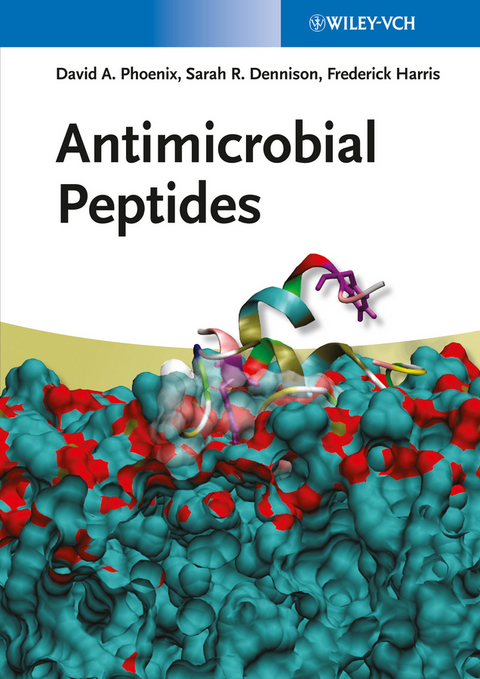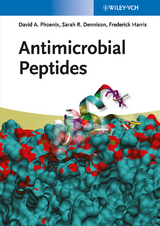Antimicrobial Peptides
Wiley-VCH (Verlag)
978-3-527-33263-2 (ISBN)
- Titel ist leider vergriffen;
keine Neuauflage - Artikel merken
The result is a highly readable and systematically structured introduction to antimicrobial peptides, their structure, biological function and mode of action.
In this text, the small team of expert authors presents the field in a comprehensive and accessible manner that is well suited for students and junior researchers.The result is a highly readable and systematically structured introduction to antimicrobial peptides, their structure, biological function and mode of action. The authors point the way towards a rational design of this potentially highly effective new class of clinical antibiotics on the brink of industrial application. They do this by discussing their design principles, target membranes and structure-activity relationships. The final part of the book describes recent successes in the application of peptides as anticancer agents.
Professor David Andrew Phoenix, OBE, AcSS, DSc studied Biochemistry at degree and doctoral level at Liverpool University which in 2009 awarded him a Doctor of Science for his impact on the field. In 2000 he was appointed Professor of Biochemistry, at the University of Central Lancashire (UCLan) and has held visiting chairs in Canada and Russia. He has published over 150 papers as well as a number of edited collections and monographs. He is a Fellow of the Royal Society of Chemistry, The Society of Biology, The Institute of Mathematics and Its Applications and the Royal Society of Medicine. Since 2008 he has been the Deputy Vice Chancellor of UCLan and also Chairs a research institute in Shenzhen focused on nanotechnology and biomedical engineering. He was made an Officer of the Most Excellent Order of the British Empire in 2010 for services to Science and Higher Education and recognized as an Academician by the Academy of Social Sciences in 2012. Dr. Sarah Rachel Dennison PhD graduated from the University of Wales, Bangor with a Bachelor of Science in Environmental Biology in 1999. Subsequently, she undertook postgraduate research in Biochemistry / Biophysics, which led to a doctorate in 2004. Currently, Sarah is a Research Associate in the School of Pharmacy and Biomedical Sciences at UCLan where she is investigating the role of amphiphilicity in the function of antimicrobial peptides using a number of biophysical techniques. Dr. Frederick Harris PhD studied at UCLan, graduating with a Bachelor of Science in Biochemistry and Microbiology in 1993 before gaining his Doctorate for work on the penicillinbinding proteins of Escherichia coli in 1998. Subsequently, he has undertaken research at Utrecht University and the Leibniz-Centre for Medicine and Biosciences, Germany. In 2000, Frederick started as a Research Fellow at UCLan and now has more than 75 publications to his name, which primarily focus on antimicrobial and anticancer peptides.
PREFACE
ANTIMICROBIAL PEPTIDES: THEIR HISTORY, EVOLUTION, AND FUNCTIONAL PROMISCUITY
Introduction: The History of Antimicrobial Peptides
AMPs: Evolutionarily Ancient Molecules
AMPs: Multifunctional Molecules
Discussion
CATIONIC ANTIMICROBIAL PEPTIDES
Introduction
CAMPs and Their Antimicrobial Action
CAMPs That Adopt an alpha-Helical Structure
CAMPs That Adopt a ß-Sheet Structure
CAMPs That Adopt Extended Structures Rich in Specific Residues
Discussion
ANIONIC ANTIMICROBIAL PEPTIDES
Introduction
AAMPs in the Respiratory Tract
AAMPs in the Brain
AAMPs in the Epidermis
AAMPs in the Epididymis
AAMPs in Blood Components
AAMPs in the Gastrointestinal Tract and Food Proteins
AAMPs and Their Structure - Function Relationships
Discussion
GRAPHICAL TECHNIQUES TO VISUALIZE THE AMPHIPHILIC STRUCTURES OF ANTIMICROBIAL PEPTIDES
Introduction
Amphiphilic Structures Adopted by AMPs
Qualitative Methods for Identifying Amphiphilic Structure
Quantitative Techniques for Analyzing Amphiphilic Structure
Discussion
MODELS FOR THE MEMBRANE INTERACTIONS OF ANTIMICROBIAL PEPTIDES
Introduction
CM-Associated Factors That Affect the Antimicrobial Action of a-CAMPs
Mechanisms Used by CAMPs for Microbial Membrane Interaction
Established Models for the Membrane Interactions of a-AMPs
Recent Novel Models for the Membrane Interactions of a-AMPs
Tilted Peptide Mechanism
Amyloidogenic Mechanisms
Discussion
SELECTIVITY AND TOXICITY OF ONCOLYTIC ANTIMICROBIAL PEPTIDES
Introduction
Peptide-Based Factors That Contribute to the Anticancer Action of Anticancer Peptides
Membrane-Based Factors That Contribute to the Anticancer Action of ACPs
Discussion
INDEX
| Erscheint lt. Verlag | 26.2.2013 |
|---|---|
| Verlagsort | Weinheim |
| Sprache | englisch |
| Maße | 170 x 240 mm |
| Gewicht | 680 g |
| Themenwelt | Medizin / Pharmazie ► Pharmazie |
| Naturwissenschaften ► Biologie ► Biochemie | |
| Naturwissenschaften ► Chemie ► Organische Chemie | |
| Schlagworte | Antimikrobieller Wirkstoff • Biochemie • biochemistry • Biomolecules (DNA, RNA, Peptides, etc.) • Biomolekül • Biomoleküle (DNA, RNA, Peptide) • Biopharmaceuticals & Pharmaceutical Biotechnology • Biopharmaceuticals & Pharmaceutical Biotechnology • Biopharmazeutika u. Pharmazeutische Biotechnologie • Biowissenschaften • Chemie • Chemistry • Life Sciences • Peptide |
| ISBN-10 | 3-527-33263-4 / 3527332634 |
| ISBN-13 | 978-3-527-33263-2 / 9783527332632 |
| Zustand | Neuware |
| Haben Sie eine Frage zum Produkt? |
aus dem Bereich




